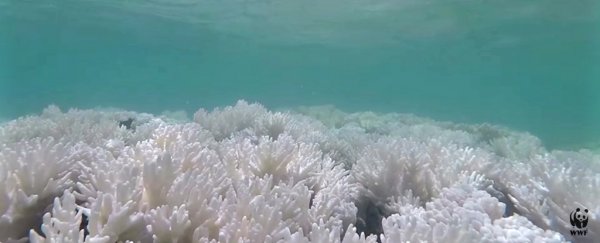A new survey has confirmed pretty much every environmentalist's worst fears, revealing that 93 percent of Australia's Great Barrier Reef has already been damaged by coral bleaching.
We just have to stop there for a second, because 93 percent!! That means there's now only 7 percent of this Natural Wonder of the World left intact thanks to rising water temperatures. How did we let it get this bad?
"We've never seen anything like this scale of bleaching before," said lead researcher Terry Hughes, who organised the National Coral Bleaching Taskforce that surveyed the reef. "In the northern Great Barrier Reef, it's like 10 cyclones have come ashore all at once."
The team has spent the past few weeks conducting aerial surveys of more than 911 individual reefs along the 2,300 km of the Great Barrier Reef, and found that only 68 of them (7 percent) had escaped bleaching. Teams of scientific divers also confirmed these results under the water.
So what does it mean to say the coral has become 'bleached'? Corals get their beautiful vibrant colour from tiny algae that live in their tissue and provide food in return for a home. But when water temperatures get too warm, the corals become stressed and eject the algae, which turns the coral bone white and also leaves them starving and vulnerable to destruction.
That looks just as devastating as you might imagine, as you can see in this recent WWF-Australia footage of the Great Barrier Reef. Guys, we really messed up:
This isn't the first mass bleaching event the Great Barrier Reef has suffered through, but the researchers say it's by far the most extreme.
But it's not all bad news. For starters, not all the reefs are equally badly damaged - just over half are 'severely bleached', which means they have bleaching of more than 60 percent.
And once ocean temperatures cool down again as Australia moves into winter, algae usually return to the corals and restores their colourful, symbiotic relationship.
But scientists aren't sure just how much damage the reef can survive, or how quickly temperatures are going to cool down after a record-hot summer.
"Towards the southern end, most of the reefs have minor to moderate bleaching and should soon recover," said Hughes. But in the northern parts of the reef, such as around Lizard Island, where 100 percent of the reefs are bleached more than 60 percent, things are a little more dire.
"The bleaching is extreme in the 1,000km region north of Port Douglas all the way up to the northern Torres Strait between Australia and Papua New Guinea," said one of the researchers, Andrew Baird from the ARC Centre of Excellence for Coral Reef Studies.
"Tragically, this is the most remote part of the Reef. North of Port Douglas, we're already measuring an average of close to 50 percent mortality of bleached corals. At some reefs, the final death toll is likely to exceed 90 percent."
"When bleaching is this severe it affects almost all coral species, including old, slow-growing corals that once lost will take decades or longer to return," he added. "[The reef's] remoteness has protected it from most human pressures: but not climate change."
Even species that the researchers thought of as 'super corals' - which meant they could cope with extreme temperature swings - have suffered up to 80 percent bleaching, the team found.
As depressing as it is, there's still hope for the reef. The most important thing we can do in light of this news is keep the pressure on the government to ramp up the shift towards renewable energy, and put the brakes on carbon emissions.
"This is a national tragedy," said a WWF-Australia spokesperson, Nick Heath. "But it will be even more of a tragedy if our political leaders don't step up to address unprecedented challenges to the very survival of the Great Barrier Reef."
"Coral drained of colour is the face of climate change," he added.
